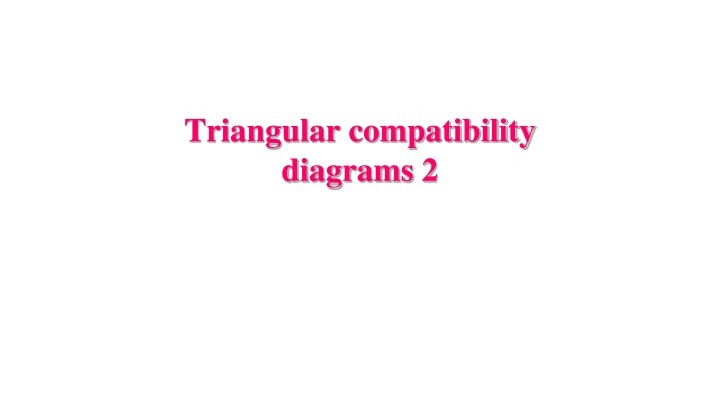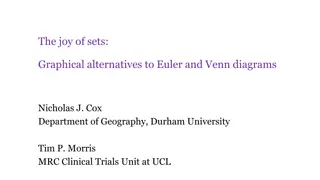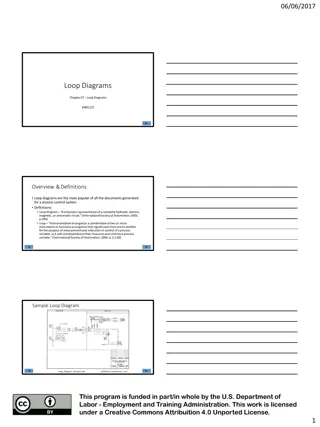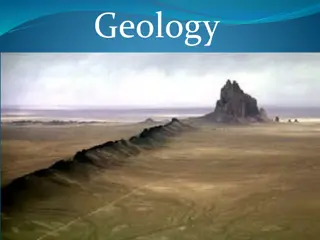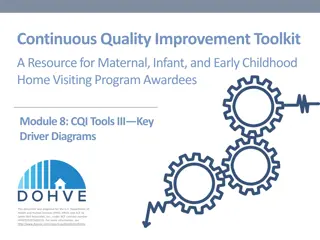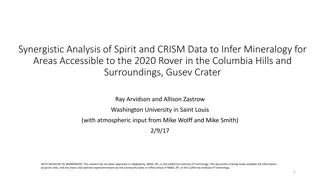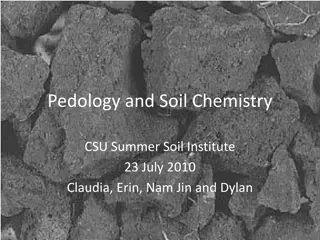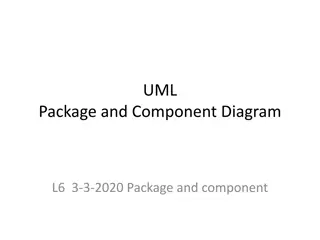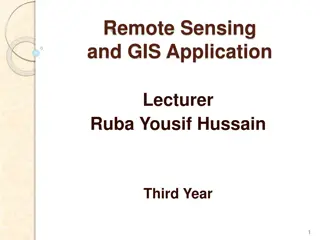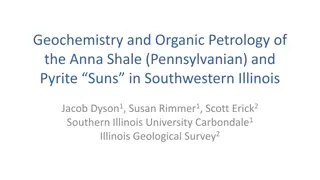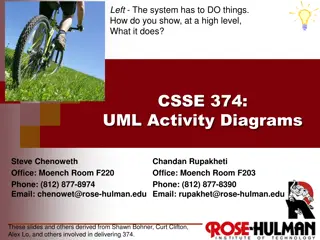Petrology Diagrams and Projections in Mineralogy Studies
Explore a series of diagrams illustrating mineralogical concepts such as compatibility, solid solutions, and phase projections in petrology and metamorphic petrology studies. These visuals cover various systems and paragenesis examples, providing insights into the behavior of elements like Fe and Mg in mineral assemblages.
Download Presentation

Please find below an Image/Link to download the presentation.
The content on the website is provided AS IS for your information and personal use only. It may not be sold, licensed, or shared on other websites without obtaining consent from the author.If you encounter any issues during the download, it is possible that the publisher has removed the file from their server.
You are allowed to download the files provided on this website for personal or commercial use, subject to the condition that they are used lawfully. All files are the property of their respective owners.
The content on the website is provided AS IS for your information and personal use only. It may not be sold, licensed, or shared on other websites without obtaining consent from the author.
E N D
Presentation Transcript
Triangular compatibility diagrams 2
Sketching Projection (MSH example) Solid solutions (jadeite-quartz-omphacite example) More complex systems faking it by lumping together Fe and Mg because they behave somewhat similarly (non-rigorous)
Figure 24-6 (p 551). After Ehlers and Blatt (1982). Petrology. Freeman.
AKF compatibility diagram (Eskola, 1915) illustrating paragenesis of pelitic hornfelses, Orij rvi region Finland Figure 24.7. (p 551). After Eskola (1915) and Turner (1981) Metamorphic Petrology. McGraw Hill.
J.B. Thompsons A(K)FM Diagram Figure 24-17 (p 556). Partitioning of Mg/Fe in minerals in ultramafic rocks, Bergell aureole, Italy After Trommsdorff and Evans (1972). A J Sci 272, 423-437.
Sketching The full KFMASH system separating effects of Fe and Mg (no faking any more)
J.B. Thompsons A(K)FM Diagram A=Al2O3 K = K2O F = FeO M = MgO
J.B. Thompsons A(K)FM Diagram Project from a phase that is present in the mineral assemblages to be studied Figure 24-18 (p 556). AKFM Projection from Mu. After Thompson (1957). Am. Min. 22, 842-858.
J.B. Thompsons A(K)FM Diagram F = FeO M = MgO A = Al2O3 - 3K2O (if projected from Ms) F = FeO M = MgO A = Al2O3 - K2O (if projected from Kfs not discussed here in detail)
J.B. Thompsons A(K)FM Diagram Biotite (from Ms): KMg2FeSi3AlO10(OH)2 A = 0.5 - 3 (0.5) = - 1 F = 1 M = 2 To normalize we multiply each by 1.0/(2 + 1 - 1) = 1.0/2 = 0.5 Thus A = -0.5 F = 0.5 M = 1 Fig 24-19 p 557
Choosing the Appropriate Chemographic Diagram Common high-grade mineral assemblage: Sil-St-Mu-Bt-Qtz-Plag Figure 24-20. (p 557) AFM Projection from Ms for mineral assemblages developed in metapelitic rocks in the lower sillimanite zone, New Hampshire After Thompson (1957). Am. Min. 22, 842-858.
Choosing the Appropriate Chemographic Diagram Figure 24-20 (p 557). After Ehlers and Blatt (1982). Petrology. Freeman. And 24-21 (p 558).
Chapter 28: Metapelites Note we start in Chapter 24 then skip to 28 Figure 28-5 (p 640). AFM projection for the biotite zone, greenschist facies, above the chloritoid isograd. The compositional ranges of common pelites and granitoids are shaded. Winter (2001) An Introduction to Igneous and Metamorphic Petrology. Prentice Hall.
Chapter 28: Metapelites Figure 28-6 (p 641) AFM projection for the upper biotite zone, greenschist facies. Although garnet is stable, it is limited to unusually Fe- rich compositions, and does not occur in natural pelites (shaded). Winter (2001) An Introduction to Igneous and Metamorphic Petrology. Prentice Hall.
Chapter 28: Metapelites Figure 28-7. AFM projection for the garnet zone, transitional to the amphibolite facies, showing the tie-line flip associated with reaction (28-8) (compare to Figure 28-6) which introduces garnet into the more Fe-rich types of common (shaded) pelites. After Spear (1993) Metamorphic Phase Equilibria and Pressure-Temperature-Time Paths. Mineral. Soc. Amer. Monograph 1. Winter (2001) An Introduction to Igneous and Metamorphic Petrology. Prentice Hall.
Chapter 28: Metapelites Figure 28-8 (p 642). An expanded view of the Grt-Cld-Chl-Bt quadrilateral from Figures 28-6 and 28-7 illustrating the tie-line flip of reaction (28-7). a. Before flip. b. During flip (at the isograd). c. After flip (above the isograd). Winter (2001) An Introduction to Igneous and Metamorphic Petrology. Prentice Hall.
Chapter 28: Metapelites Figure 28-9. AFM projection in the lower staurolite zone of the amphibolite facies, showing the change in topology associated with reaction (28-9) in which the lower-grade Cld-Ky tie-line (dashed) is lost and replaced by the St-Chl tie-line. This reaction introduced staurolite to only a small range of Al-rich metapelites. After Spear (1993) Metamorphic Phase Equilibria and Pressure-Temperature-Time Paths. Mineral. Soc. Amer. Monograph 1. Winter (2001) An Introduction to Igneous and Metamorphic Petrology. Prentice Hall.
Chapter 28: Metapelites Figure 28-10 (p 643). AFM projection in the staurolite zone of the amphibolite facies, showing the change in topology associated with the terminal reaction (28-11) in which chloritoid is lost (lost tie-lines are dashed), yielding to the Grt-St-Chl sub-triangle that surrounds it. Winter (2001) An Introduction to Igneous and Metamorphic Petrology. Prentice Hall.
Chapter 28: Metapelites Figure 28-11. AFM diagram for the staurolite zone, amphibolite facies, showing the tie-line flip associated with reaction (28-12) which introduces staurolite into many low-Al common pelites (shaded). After Carmichael (1970) J. Petrol., 11, 147-181. Winter (2001) An Introduction to Igneous and Metamorphic Petrology. Prentice Hall.
Chapter 28: Metapelites Figure 28-11. AFM diagram for the staurolite zone, amphibolite facies, showing the tie-line flip associated with reaction (28-12) which introduces staurolite into many low-Al common pelites (shaded). After Carmichael (1970) J. Petrol., 11, 147-181. Winter (2001) An Introduction to Igneous and Metamorphic Petrology. Prentice Hall.
Fig 24-4 (p 549) Note we skip back to Chapter 24 Figure 24-4. After Ehlers and Blatt (1982). Petrology. Freeman. And Miyashiro (1994) Metamorphic Petrology. Oxford.
A typical ACF compatibility diagram, referring to a specific range of P and T (the kyanite zone in the Scottish Highlands) Figure 24-5. After Turner (1981). Metamorphic Petrology. McGraw Hill.
